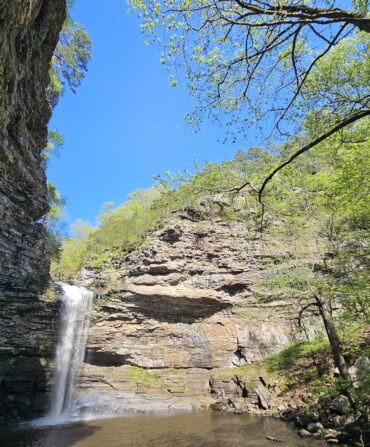Even before dawn, the robins along the Crystal Bridges Trail in Bentonville, Arkansas, were in full throat. Their songs were so persistent and clear, I wondered whether they were part of a sound installation piped from unseen speakers, joining the other works on the grounds around the Crystal Bridges Museum of American Art. Pieces like James Turrell’s The Way of Color, one of the artist’s famous experiential light installations, called Skyspaces, and my destination at that early hour.
Ten minutes before dawn, the Skyspace—a circular native-stone building with a round cutout in the roof—hosts a beautifully hypnotic LED light show in collaboration with the Ozarks’ emerging morning light. I took a seat on the stone bench ringing the interior, my back pressed against the wall, which is tilted out to direct your eyes upward. Over the forty-five-minute cycle, the installation’s lights transmogrified the sky, changing the color inside the disk from royal blue to forest green to teal. Focusing on a specific circle of sky caused it to resemble a trompe l’oeil Renaissance ceiling, or the sweeping skies of a Hudson River School painter. Dawn came, the LEDs dimmed, and I emerged newly observant and alert.
Turrell’s seductive work seems an apt representation of what Crystal Bridges has done for Northwest Arkansas: taken an overlooked corner of the landscape and thoroughly transformed it through art. Since it opened in 2011, the museum, conceived and funded by Walmart heir Alice Walton, has seen more than 2.5 million visitors, stirring the sleepy town of Bentonville to become a world-class art destination. Concurrently and in its wake, boutique hotels, sleek restaurants, fashionable stores, microbreweries, and even a film festival have sprung up. Students from all over the region are now a mere day trip away from the kind of art available previously in only the largest cities. The march of art continues: Last fall, Crystal Bridges added one of Frank Lloyd Wright’s Usonian homes to its grounds. And the museum announced this past spring that a former Kraft Foods factory about a mile from the square will open in 2018 as a massive space for both contemporary and performance art, along the lines of the Museum of Modern Art’s P.S. 1.
Photo: Tara Donne
Waffles with seared foie gras at Pressroom.
1 of 5
Photo: Tara Donne
Roxy Paine’s stainless-steel sculpture Yield at the entrance to Crystal Bridges.
2 of 5
Photo: Tara Donne
The Crepes Paulette food truck.
3 of 5
Photo: Tara Donne
Inside Thorncrown Chapel.
4 of 5
Photo: Tara Donne
Marman, by Louise Bourgeois.
5 of 5
The ripples from dropping Crystal Bridges into the still pond of Bentonville have extended to Fayetteville, the university town in thrall to Razorback sports a half hour south, and to Eureka Springs, a longtime counterculture hamlet an hour east through the Ozarks. Both had lively homegrown art scenes before the arrival of Crystal Bridges, but the art communities there have seen heightened attention and opportunity from the museum’s popularity.
Cynthia Post Hunt, a California native who studied at the School of the Art Institute of Chicago and who moved with her husband to Fayetteville two years ago, cofounded the INVERSE Performance Art Festival this year. She attended a 2014 contemporary art show at Crystal Bridges and was encouraged by the attention paid to her particular field. “When they announced the new Kraft space,” she says, “we bought a bottle of champagne and celebrated.”

Tara Donne
Artsy traffic boxes in Fayetteville.
Eureka Springs has many charms all its own—restored Victorian homes and buildings, steep streets and stone staircases, and a welcome embrace of both fundamentalist Christians and LGBT advocates—and many people who append a visit to their Crystal Bridges trip are discovering its quirky singularity. Rick Rojek, the proprietor with his wife, Cheri, of the Heartstone Inn, a Eureka Springs B&B, says that there’s basically no off-season now. Bookings come from New York and Los Angeles, whereas most guests used to come from within a six-hour drive.
One artist I spoke to referred to Bentonville somewhat disdainfully as a “totally curated community,” where pricey coffee and farm-to-table meals might abound but an organic community of artists would never arise, as it already had in Fayetteville and Eureka Springs. I took her point: As long as Walmart money, even in its most beneficent form, directs so much of the town, the struggle and striving and necessary crucible of, say, the Lower East Side of New York in the 1980s might be impossible. On the other hand, the Medici pretty much owned Renaissance Florence as well.
In any case, Crystal Bridges is there, and perhaps there’s some Caravaggio-to-be of the Ozarks who wouldn’t otherwise have seen a Mark Rothko or a Georgia O’Keeffe or Carroll Cloar’s Charlie Mae Practicing for the Baptising, or Maya Lin’s Silver Upper White River, both inspired by Arkansas landscapes. Without Crystal Bridges, he or she wouldn’t then have been able to emerge, as I did from the Skyspace, blinking and changed.














